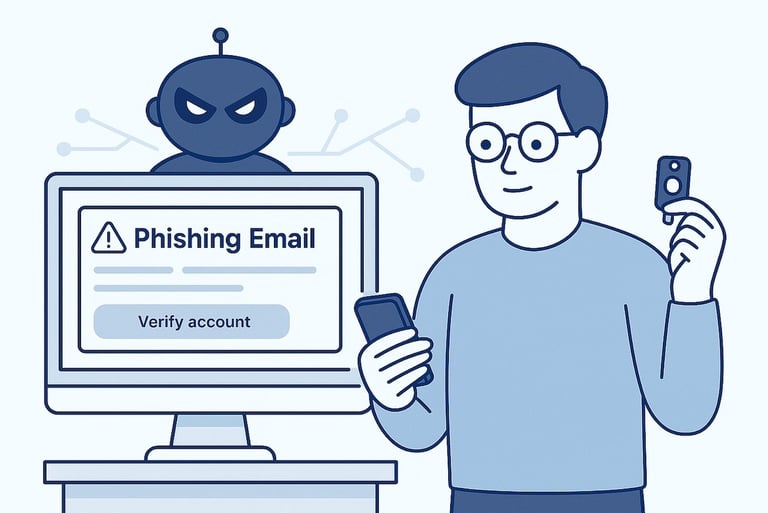AI-Powered Cyberattacks Are Skyrocketing. Here's How to Stay Safe
After creating a convincing digital twin of myself, I explore how AI is fueling a 12,000% increase in cyberattacks and share the practical security strategies that both AI pioneers and cybersecurity experts are implementing to stay protected.
AI TECHNOLOGY
Grant DeCecco
6/17/20254 min read


A few months ago, I created a digital twin of myself for my birthday party. As guests arrived, my AI double welcomed them personally—switching seamlessly between English and Portuguese. The reactions were priceless, but also unsettling. No one could tell it wasn't really me until the twin's Portuguese was notably better than mine.
That experiment became a lot less fun when I watched Dr. Geoffrey Hinton—the "Godfather of AI"—on The Diary of a CEO. He revealed that phishing attacks had increased by more than 12,000% between 2023 and 2024. The culprit? The same AI technology I'd been playing with at my party.
What I created for entertainment, cybercriminals are weaponizing at an unprecedented scale. And if someone like me can fool my closest friends and family with AI, imagine what professional scammers can do to unsuspecting targets.
The New Reality: When AI Becomes the Weapon
Hinton's warnings aren't theoretical—they're happening right now. During the interview, he shared how scammers had cloned his own voice and image to promote fake cryptocurrency schemes. The deepfakes were so convincing that people couldn't tell the difference, and the fake ads were nearly impossible to stop once they started spreading.
This represents a fundamental shift in cybercrime. Traditional attacks required human effort that didn't scale well. Now, AI can generate thousands of personalized phishing emails in minutes, create convincing deepfake videos of trusted figures, and even scan millions of lines of code to find vulnerabilities that humans would miss.
My birthday party trick suddenly felt a lot more ominous. If I could create a convincing digital version of myself in a few hours, what could someone with malicious intent accomplish?
Beyond Phishing: The Full Spectrum of AI-Enhanced Threats
The scope of AI-powered attacks extends far beyond email scams:
Voice and Video Impersonation has become frighteningly sophisticated. Scammers can now clone voices from just a few seconds of audio—perhaps from a social media video or voicemail greeting. They're using these to impersonate CEOs requesting urgent wire transfers or family members claiming to be in emergency situations.
Hyper-Personalized Social Engineering leverages AI's ability to analyze vast amounts of public data. Attackers can craft messages that reference your recent activities, mutual connections, or professional interests with uncanny accuracy, making their communications appear legitimate.
Academic and Professional Impersonation is creating chaos in trusted institutions. Hinton mentioned fake research papers being published with his name to artificially boost citation counts, undermining the integrity of academic discourse.
The common thread? AI has democratized sophisticated attack techniques that previously required significant resources and expertise.
Your Defense Strategy: Lessons from the Frontlines
When someone who helped create AI starts changing his personal security practices, it's time to pay attention. Here are the defensive strategies Hinton himself is implementing, along with additional measures I recommend to clients and implement myself:
Diversify Your Financial Exposure. Hinton now keeps money across three different banks specifically to limit damage if one institution is compromised. This isn't paranoia—it's risk management. Consider spreading your assets across multiple financial institutions and investment platforms.
Embrace Offline Backups. Hinton backs up his laptop regularly to a hard drive that stays disconnected from the internet. Ransomware can't encrypt what it can't reach. Set up monthly backups to an encrypted external drive, and store it separately from your main devices.
Upgrade Your Authentication. Multi-factor authentication using SMS isn't enough anymore—SIM swapping attacks can intercept those codes. Hardware security keys like YubiKeys provide much stronger protection and are nearly impossible to phish. Use them for your most critical accounts: banking, email, and cloud storage.
Implement Verification Protocols. My digital twin experiment taught me that we can no longer trust audio or video messages at face value. Establish verification procedures with family members and colleagues. If someone contacts you urgently claiming to be in trouble or requesting sensitive information, verify through a separate communication channel before responding.
Audit Your AI Usage. Many people inadvertently feed sensitive information to AI systems without understanding where that data goes. Avoid entering confidential information into public AI tools, and ask your employer about their AI governance policies. Your casual interaction with ChatGPT might be training tomorrow's models.
The Mindset Shift We Need
Hinton made a sobering observation during the interview: "We've never had to deal with something smarter than us before." This isn't about becoming paranoid—it's about acknowledging that our threat landscape has fundamentally changed.
The same AI capabilities that help us draft emails, analyze data, and automate workflows are being turned against us by attackers who move faster than traditional security measures can adapt. We need to evolve our defensive thinking to match this new reality.
My experience with AI has taught me that these tools are incredibly powerful and surprisingly accessible. That's exciting for legitimate applications, but it also means we can't rely on cybersecurity approaches designed for a pre-AI world.
Moving Forward: Vigilance Without Paralysis
The goal isn't to fear AI but to respect its capabilities—both beneficial and malicious. By understanding how these attacks work and implementing layered defenses, we can continue to benefit from AI innovation while protecting ourselves from its misuse.
The cybersecurity landscape is evolving rapidly, and staying informed is part of staying safe. As someone who works at the intersection of AI and business strategy, I'm committed to sharing insights about these emerging challenges and practical solutions for addressing them.
If you're a business leader navigating AI implementation and security challenges, I'd love to connect. Follow me on LinkedIn or subscribe to this blog for more insights on leading safely in our AI-powered future.
